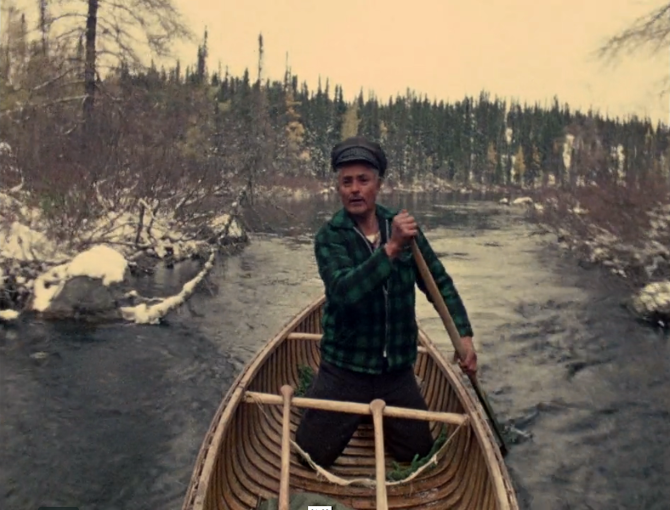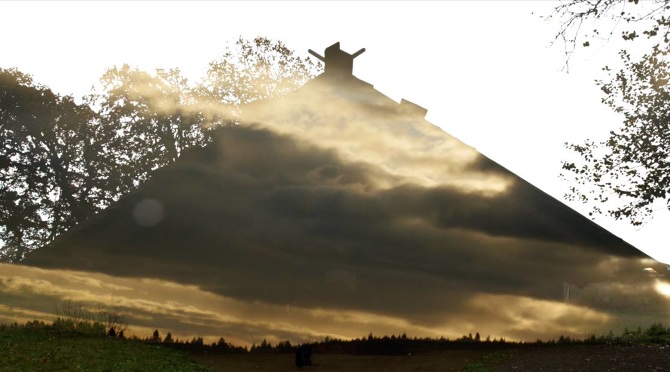This Landscape Tells Stories: Caroline Monnet and Sky Hopinka
Friday June 22, 2017 7:30 Doors/8 Screening
$8/$5 members + students
@ CineCycle, 129 Spadina Avenue
In the past decade these First Nations artists have lit up screens with a fabulous variety of makings, their lyrical essay docs feel like home. Both share the need to reimagine the land, its naming and picturing, each frame another step on the journey of redress and reclamation. Caroline’s work stretches from her trilogy of Winnipeg high school docs to her recent award-winning revisit of the NFB archives. Sky’s landscape memorials are part of an ongoing conversation between elders and a vanishing scape of language and land.
Intro
How is it possible to look forward without looking back? Even this place here, has been the site of human activity for 15,000 years.
This is the traditional territory of the Haudenosaunee, the Huron-Wendat and the Mississaugas of the Credit River. This place here was the subject of the Dish With One Spoon Wampum Belt Covenant, an agreement between the Iroquois Confederacy and the Ojibwe and allied nations to peaceably share and care for the resources around the Great Lakes. Our pictures and sounds, even our conversations, perhaps these are also resources that can be shared peaceably.
First Stories: Caroline Monnet
Caroline Monnet was born in 1985 in Ottawa. The daughter of an Algonquin mother and a French father, she studied sociology and communication in Spain and Canada. She made her first movie Ikwe, which we’ll show tonight, in 2009, and has made nearly two shorts per year since. She’s also active as a visual artist, embedding Indigenous remnants and bead work into concrete blocks, for instance, or creating teepees for galleries, which sometimes provide new frames for her movies. Her work has a documentary lean, sometimes it’s Indigenous high school students in Winnipeg, or the only Indigenous-owned train service in the country. And there is a demand, above all, that it should be beautiful, shimmering, complicated. The final work in the program is called Mobilize, in which the artist mobilizes in just 3 minutes the archives of the National Film Board to order to recenter the picture, and offer us a very different orientation on our own history.
Ikwe 4:45 minutes 2009
An intimate family drama laid into the landscape of a face. What cannot be read there, shown there, what has not already been lived? Ikwe convenes a lunar compact with her grandmother and the moon in this luminously lyric short.
Tashina 4:51 minutes 2010
Another gorgeoursly lensed documentary brief. Tashina Monias has left the reserve in order to come to a better school in Winnipeg. Broken phone calls home underline just how far away from home she is. Frozen wastes, a bridge crossing, the light in pine trees. Shots of the emptied school emphasize a geometry of repetitive order, a slightly menacing conformity where she appears as the only figure striding past the empty lockers, or else sitting between the library stacks while the camera slowly zooms away. Part of a trilogy of experimental docs (Warchild, Kwoni) made about First Nations youth who board at South East Collegiate in Winnipeg.
Gephyrophobia 2:18 minutes 2012
The title means fear of bridges, and the camera stands poised, or else races alongside the borders, of the boundary zone bridges that link English and French Canada, downtown Winnipeg and the North End, communities that are divided by, but also have in common, the Ottawa River. The artist’s strong frames and clear seeing propel these unpopulated gestures that redraw boundary lines even as it throws them into question.
“The bridge she is documenting in Gephyrophobia is between Hull, Ontario and Gatineau, Quebec…French and English Canada…but it immediately made me think of the cultural gap between Winnipeg and the North End on first viewing. Bridges that divide us.” Clint Enns
Tshiuetin 10 minutes 2016
The artist takes us on a trip on the first Indigenous-owned train service (Tshiuetin means “north wind”) in Canada, running in northern Quebec. Using a deft series of musical interludes and spoken word recounts by the train’s conductor, she manages a portrait of the land that is also a return to identity and origins. Beautifully composed as usual, her camera work comes straight from her heart.
The Black Case 13 minutes 2014 (with Daniel Watchorn)
Shot in a fathomlessly deep noir palette, the artist brings us a long night at a boarding school for Native kids. The doctors are white monsters with unwanted touches and a mission from Jesus, the nightmares are snowbound, while each patient/child lies in a bricked up solitary where sick cries are met by songs of consolation until a final reckless judgement. Nearly wordless, the artists conjure a world of small gestures, a boy curling up on a bed, a woman lifting implements from a drawer, a death that tries to be small. Handsomely produced, with roles carved out for cast and costumes, the artist maintains her particular way of seeing, the money doesn’t turn the vision, but opens newly accessible forms.
Mobilize by Caroline Monnet 3 minutes 2015
An exhilarating rush of a trip, the artist mobilizes the archives of the National Film Board in order to produce a trek from Canada’s northern reaches to the cities in the south. Every shot is a wonder, as Monnet reframes the archive with an aboriginal lens, allowing snowshoers, paddlers, strollers and iron walkers to cross the new screen of the eye. The score is by Polaris winner Tanja Tagaq.
Second Stories: Sky Hopinka
Sky Hopinka was born in a small town in Washington State in 1984 and currently lives in Milwaukee. Not the most economically happy place in the American universe. He is a Ho-Chunk Nation national and descendent of the Pechanga Band of Luiseño Indians. He’s made eight short movies, experimentalisms that take a second look at land and language. Tonight we’re going to watch three of his 8 movies, including the most recent, which is on view at the Whitney Biennale, but we’ll be showing it as it was meant to be seen, from beginning to end, in the temporary darkness where the artist asks us to reimagine the power of names and naming, the pictures that language create.
Anti-Objects, or Space Without Path or Boundary 13:05 minutes 2017
It’s all about the frame, as soon as the frame changes, everything looks different, even Portland. The artist turns the city into a language lesson with his spirit guide, rumbling through Chinuk Wawa, a Native American language from the Pacific Northwest. Bridges, forest paths and abstract colourations are sites of possible pleasures and transitions, in-between places, roads along the way. The natural world is every bit as alive as the one who sees it, leaves quiver in the wind, the waterfall pours. The camera moves alongside, just as Sky accompanies his pal, side by side, becoming parts of each other, learning the language, the customs, the drenching soggy light of this land. There is eating, walking, resting, sleeping. And at night the dreams come in pyramids, and the ancestors are alive because remembered.
I’ll Remember You as You Were, Not as What You’ll Become 12:35 2016
A memorial and celebration of the late, indigenous, lower-east-side poet Diane Burns (1957-2006) who sent up Native stereotypes in her sharply irreverent lines. A chorus of dreamy, colour-transfigured dancers fill the screen with joy. Solemn lights animate the forest. “No I didn’t make it rain tonight.” Conjurings of extinction as a car races into a magic hour sunset. The poet appears onstage, tapping the mic in a rhythm of yes. Hopinka reconnects Burns with the land, where everything is alive, singing, turning, lighting up, not yet sunken into the bottle, her lost child waiting, waiting. Here is the dream future, the road not taken, an offering of thanks from one artist to another. Let’s kiss again in the afterworld and turn into light together.
Visions of an Island 15 minutes 2016
There is an island on the Bering Sea, between Russia and Alaska. Could it be imagined outside of language, and what does it mean if that language is indigenous, and in danger of disappearing? If the words go, does the geography follow? An Unangam Tunuu elder maps out the wildlife and terrain. Students roll the old words over their tongues. In a series of spendidly coloured frames and clear lookings, the artist grazes the land until it turns upside down. Who belongs here? The concentration, the gravity of each footfall, lends the artist’s seeing an uncanny intensity, every frame burns with resolve and supernatural certainty.

